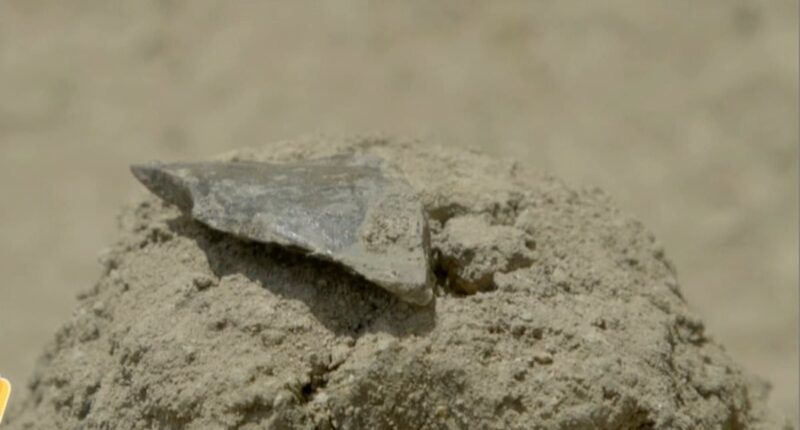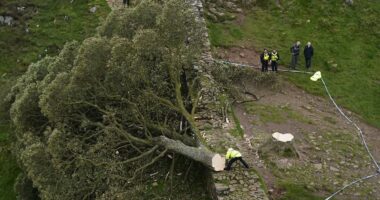Archaeologists have discovered some of the first-ever tools used on Earth at a site in Africa dubbed ‘the cradle of humankind.’
Located in the Homa Peninsula of Kenya, this area has revealed important information about the early history of humanity. Among the discoveries are ancient tools and the remains of ‘Lucy’, a pre-human ancestor that roamed the Earth over three million years ago.
The research team unearthed flakes dating back three million years, believed to be small knives crafted by hominins, one of the earliest human ancestors to walk upright. These hominins used a technique of striking one stone against another to create sharp cutting edges.
Experts from the City University of New York suggest that these sharpened rocks were likely used by hominins to peel and chop fruits and vegetables, as well as to slice through the meat of hippos for consumption.
The tools are known as the Oldowan tool kit, which previously only spanned from 1.7 million years to 2.9 million years ago.
Lead archaeologist Tom Plummer suggested that the tools found paved the way for everything that followed.
‘In terms of technology, I think the Oldowan technology is the most important technological innovation that ever happened in human history,’ Plummer told CBS News.
‘It allowed hominins to access a whole array of foods that they never had access to before, fueling body and brain size increases.’

Archaeologists have discovered some of the first tools used on Earth. The artifacts are stones that ancient humans sharpened
The new diet would have sparked a ‘feedback loop’ that led to more sophisticated beings and advanced technologies, Plummer said.
While uncovering the tools was an amazing discovery for Plummer and his team, finding cut marks on nearby animal bones confirmed butchery was done.
The team uncovered ancient hippo bones at the site, which showed that technology existed nearly three million years ago, CBS News reported.
The site is located on the peninsula called Nyanga, which experts said could help frame humans’ existence on Earth.
Rick Potts, the director of the Smithsonian’s human origins program and the leader of research on the peninsula, said: ‘We are the last biped standing, as I call it.
‘All of those other ways of life became extinct. And so that gives us a lot to think about, and it draws attention to the fragility of life, even in our own journey through time.’
Scientists have found evidence showing that modern humans appeared in Africa about 300,000 years ago – 600,000 years after hominins went extinct – but they only recently understood that the pre-human group began walking upright at least six million years ago.
‘Some of the things that we thought occurred in a very short period of time, within the last one million years, are now stretched out over a six million year period,’ Potts said. ‘That includes tool making.’

The tools were uncovered Kenya’s Homa Peninsula, a region that has produced clues about humanity’s early beginnings

Researchers at the City University of New York said the sharpened rock allowed them to peel and cut fruits and vegetables and slice the flesh of hippos
Archaeologists uncovered the remains of ‘Lucy’ in 1974, celebrating with beer and listening to the Beatles.
And when the song ‘Lucy in the Sky with Diamonds,’ the team knew what to name the ancient species that lived 3.2 million years ago.
In 2016, researchers re-examined her bones to learn more about how she died, finding a simple fall out of a tree may have caused her death.
Lead author John Kappelman, a University of Texas professor in anthropology, said: ‘It is ironic that the fossil at the center of a debate about the role of arborealism in human evolution likely died from injuries suffered from a fall out of a tree.
Kappelman first studied Lucy during her US museum tour in 2008, when the fossil detoured to the High-Resolution X-ray Computed Tomography Facility (UTCT).
The facility has a machine designed to scan through materials as solid as a rock and at a higher resolution than medical CT.
For 10 days, Kappelman and geological sciences professor Richard Ketcham scanned all of her 40-percent-complete skeleton to create a digital archive of more than 35,000 CT slices.

Remains of Lucy, an ancient human species that lived more than three million years ago, was also found in the region
Kappelman noticed the end of her right humerus was fractured in a manner not normally seen in fossils, preserving a series of sharp, clean breaks with tiny bone fragments and slivers still in place.
This compressive fracture results when the hand hits the ground during a fall, impacting the elements of the shoulder against one another to create a unique signature on the humerus,’ said Kappelman.
He then consulted Dr Stephen Pearce, an orthopedic surgeon at Austin Bone and Joint Clinic, using a modern human-scale, 3D printed model of Lucy.
Pearce confirmed that the injury was consistent with fracture caused by a fall from considerable height when the conscious victim stretched out an arm in an attempt to break the fall.
Kappelman also saw similar, less severe, fractures at the left shoulder and other compressive fractures throughout Lucy’s skeleton.
Overall, Lucy suffered a broken ankle, arm, knee, pelvis and at least one fractured rib – suggesting she must have suffered severe internal organ damage.

















